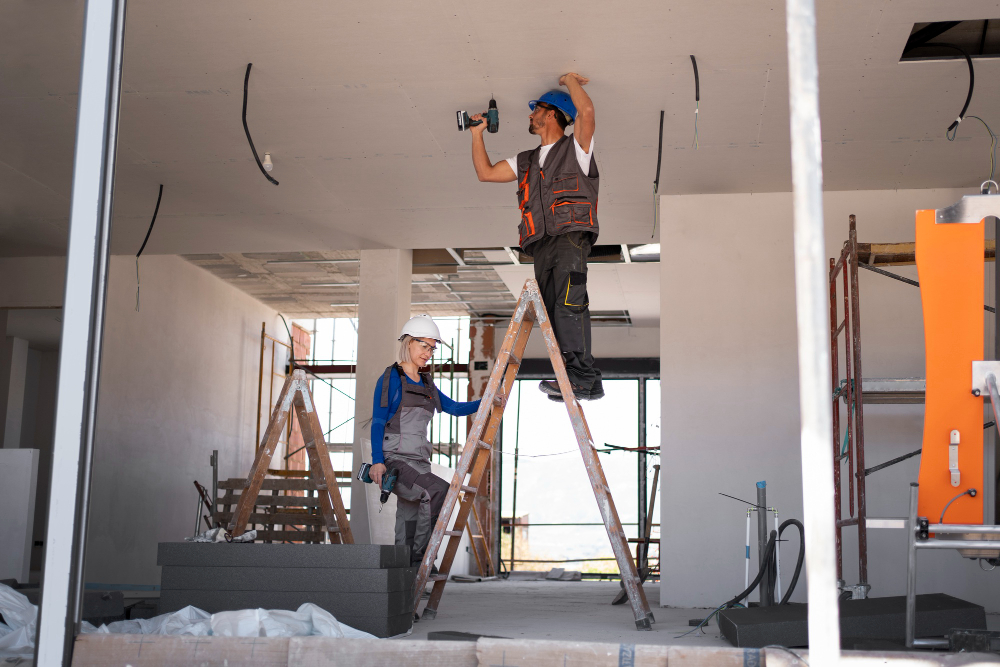Top Plafonnage Materials for Durable Wall Finishes
When it comes to achieving a durable and aesthetically pleasing wall finish, selecting the right plafonnage materials is crucial. Plafonnage, or plastering, plays a significant role in both the structural integrity and visual appeal of interior and exterior walls. Among the top materials used for plafonnage, cement-based plasters stand out for their robustness and versatility. These plasters offer excellent durability, weather resistance, and can be applied to various surfaces, making them ideal for both residential and commercial projects. Another popular choice is lime plaster, known for its breathability and flexibility. Lime plasters not only provide a smooth finish but also allow walls to regulate moisture effectively, which helps prevent mold and mildew growth. Additionally, lime plasters offer a timeless aesthetic, often chosen for restoration projects due to their historical authenticity. Understanding the characteristics and benefits of different plafonnage materials is essential for achieving long-lasting and visually appealing wall finishes tailored to specific project needs.
Introduction to Plafonnage Materials

Plafonnage, also known as wall plastering or rendering, plays a crucial role in achieving durable and aesthetically pleasing wall finishes. The choice of plafonnage materials significantly impacts the durability, appearance, and maintenance requirements of walls in both residential and commercial buildings. Understanding the characteristics and benefits of various plafonnage materials is essential for making informed decisions that align with your project goals. Let’s explore eight popular plafonnage materials in detail:
Cement-Based Plafonnage: Strength and Durability
Cement-based plafonnage is renowned for its robustness and durability, making it a preferred choice for high-traffic areas and exterior walls. Composed of cement, sand, and sometimes additives for improved workability and adhesion, this material forms a solid bond with substrates, creating a resilient surface that withstands weathering and mechanical stress. Its application involves layering and smoothing techniques that ensure a uniform finish suitable for painting or decorative treatments..
Lime Plaster: Traditional Charm with Modern Durability
Lime plaster blends historical craftsmanship with contemporary durability, offering a breathable and flexible finish that adapts well to varying climatic conditions. Made from lime, sand, and water, this material allows walls to regulate moisture naturally, preventing issues like mold and dampness. Lime plaster’s unique properties include its self-healing capability, as it can mend hairline cracks over time without compromising its integrity. Its application requires skilled craftsmanship to achieve a smooth, decorative surface suitable for heritage restoration projects or modern interiors seeking a touch of timeless elegance.
Gypsum Plafonnage: Versatility and Smooth Finishes
Gypsum plafonnage stands out for its versatility and ability to deliver flawless, smooth finishes ideal for interior walls and ceilings. Composed of gypsum powder and additives that enhance workability and setting time, this material offers quick installation and minimal shrinkage during drying. Its lightweight nature reduces structural load and facilitates easy application on various substrates, including concrete, wood, and metal. Gypsum plafonnage also boasts excellent fire resistance and acoustic properties, making it suitable for spaces that require enhanced safety and sound insulation.
Acrylic Plafonnage: Modern Solution for Resilient Walls
Acrylic plafonnage represents a modern solution designed for both interior and exterior wall finishes, offering enhanced durability and weather resistance. Formulated with acrylic polymers, mineral fillers, and additives, this material forms a flexible and resilient coating that adapts well to substrate movements and environmental changes. Acrylic plafonnage excels in resisting cracking, fading, and mildew growth, making it suitable for high-moisture areas or climates with extreme temperature variations. Its application involves straightforward techniques such as rolling or spraying, allowing for efficient coverage and customization with various textures and colors.
Clay Plafonnage: Natural Beauty and Sustainable Durability
Clay plafonnage embodies natural beauty and sustainability, offering a breathable and environmentally friendly alternative for interior wall finishes. Made from clay minerals, aggregates, and natural fibers, this material regulates indoor humidity levels by absorbing and releasing moisture, creating a comfortable and healthy living environment. Clay plafonnage’s thermal insulation properties contribute to energy efficiency, reducing heating and cooling costs over time. Its application involves techniques like hand plastering or spraying, allowing for artistic expression through texture and finish variations.
Gypsum Plafonnage: Versatility and Smooth Finishes
Gypsum plafonnage stands as a versatile and widely appreciated material in the realm of wall finishes, prized for its smooth texture, ease of application, and aesthetic adaptability. Composed primarily of gypsum powder, along with additives to enhance workability and setting time, this material offers unique advantages that make it suitable for various interior applications. Whether used in residential homes, commercial spaces, or institutional buildings, gypsum plafonnage excels in delivering impeccable surfaces that serve as ideal canvases for further decoration or provide a clean, minimalist aesthetic on their own.
Composition and Properties of Gypsum Plafonnage
Gypsum plafonnage derives its properties from gypsum, a mineral known for its excellent fire resistance and sound insulation capabilities. The plafonnage mixture typically includes gypsum powder, water, and additives such as accelerators or retarders to control setting time and improve workability. This composition ensures that gypsum plafonnage can be applied smoothly and evenly onto various substrates, ranging from concrete and masonry to drywall and plasterboard.
Application Techniques for Gypsum Plafonnage
The application of gypsum plafonnage involves several key techniques to achieve its trademark smooth finish. Initially, the substrate must be clean, dry, and free of dust or debris to ensure proper adhesion. Skilled craftsmen or contractors typically mix the gypsum powder with water to form a workable paste, which is then applied using trowels or spraying equipment.
Advantages of Gypsum Plafonnage
One of the primary advantages of gypsum plafonnage lies in its smooth finish, which provides an ideal base for achieving a polished, professional look in interior spaces. Unlike traditional cement-based plasters, gypsum plafonnage exhibits minimal shrinkage during drying, reducing the likelihood of cracks appearing over time. Its lightweight nature also contributes to easier handling and application, making it suitable for both new construction projects and renovation work where time and efficiency are crucial factors.
Fire Resistance and Safety Benefits
Gypsum plafonnage is renowned for its exceptional fire resistance, offering crucial protection in buildings by slowing down the spread of flames and reducing smoke development. This property makes it a preferred choice for interior applications where fire safety regulations are stringent, such as in residential buildings, hospitals, and educational institutions. Its ability to form a barrier against heat and flames enhances overall building safety and may contribute to lower insurance premiums for property owners.
Sound Insulation Properties
In addition to fire resistance, gypsum plafonnage provides effective sound insulation properties, reducing airborne noise transmission between rooms or floors. This acoustic benefit enhances privacy and comfort in residential settings and improves concentration levels in office environments. By absorbing sound vibrations and minimizing sound transmission, gypsum plafonnage helps create quieter and more peaceful indoor environments conducive to relaxation, work, or study.
Choosing the Right Plafonnage Material for Your Project
Selecting the appropriate plafonnage material is crucial for achieving both aesthetic appeal and functional durability in your project. Each type offers unique advantages suited to different environments and design preferences. Here are key points to consider:
- Material Properties: Understand the specific properties of each plafonnage material—such as gypsum, cement, lime, acrylic, clay, and resin-based options—to match them with your project’s requirements for durability, fire resistance, moisture control, and acoustic performance.
- Application Considerations: Consider the application ease and suitability of each material for your project’s substrate and location, whether interior or exterior. Some materials may require specialized techniques or conditions for optimal performance.
- Aesthetic Versatility: Evaluate how each material contributes to your desired aesthetic. Some, like gypsum and acrylic, offer smooth finishes ideal for painting or decorative treatments, while others, such as clay or lime, provide textured surfaces for a more rustic or natural look.
- Environmental Impact: Assess the sustainability aspects of each material, including its energy consumption during production, recyclability, and potential indoor air quality benefits. Opt for materials that align with green building certifications if sustainability is a priority.
Conclusion
Selecting the right plafonnage materials is crucial for achieving durable and aesthetically pleasing wall finishes. Whether you prioritize longevity, ease of maintenance, or a specific aesthetic, the materials mentioned in this blog – such as gypsum plaster, lime plaster, and cement-based plasters – offer distinct advantages tailored to various needs. Gypsum plaster, known for its smooth finish and quick drying time, is ideal for interior walls requiring frequent touch-ups. Lime plaster, with its breathability and antimicrobial properties, suits both historical restoration projects and eco-conscious modern designs. Cement-based plasters, noted for their robustness and resistance to moisture, are perfect for exterior applications and areas prone to dampness.
For further inquiries or to explore how our expertise in plafonnage can enhance your residential or commercial project in Bruxelles and beyond, don’t hesitate to contact Bruxelles Plafonnage BEL MRSC. Reach us at +3246020154, and our knowledgeable team will gladly assist you with choosing the best materials and techniques for achieving durable and impeccable wall finishes. Your satisfaction and the longevity of your walls are our priorities.


